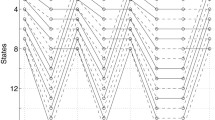Abstract
The error-correcting capability of tailbiting codes generated by convolutional encoders is described. In order to obtain a description beyond what the minimum distance d min of the tailbiting code implies, the active tailbiting segment distance is introduced. The description of correctable error patterns via active distances leads to an upper bound on the decoding block error probability of tailbiting codes. The necessary length of a tailbiting code so that its minimum distance is equal to the free distance d free of the convolutional code encoded by the same encoder is easily obtained from the active tailbiting segment distance. This is useful when designing and analyzing concatenated convolutional codes with component codes that are terminated using the tailbiting method. Lower bounds on the active tailbiting segment distance and an upper bound on the ratio between the tailbiting length and memory of the convolutional generator matrix such that d min equals d free are derived. Furthermore, affine lower bounds on the active tailbiting segment distance suggest that good tailbiting codes are generated by convolutional encoders with large active-distance slopes.
Similar content being viewed by others
REFERENCES
Solomon, G. and van Tilborg, H.C.A., A Connection Between Block and Convolutional Codes, SIAM J. Appl. Math., 1979, vol. 37, no. 2, pp. 358-369.
Ma, J.H. and Wolf, J.K., On Tail-Biting Convolutional Codes, IEEE Trans. Commun., 1986, vol. 34, no. 2, pp. 104-111.
Bocharova, I.E., Johannesson, R., Kudryashov, B.D., and Stähl, P., Tailbiting Codes: Bounds and Search Results, IEEE Trans. Inf. Theory, 2002, vol. 48, no. 1, pp. 137-148.
Stähl, P., Anderson, J.B., and Johannesson, R., Optimal and Near-Optimal Encoders for Short and Moderate-Length Tailbiting Trellises, IEEE Trans. Inf. Theory, 1999, vol. 45, no. 7, pp. 2562-2572.
Höst, S., Johannesson, R., Zigangirov, K.Sh., and Zyablov, V.V., Active Distances for Convolutional Codes, IEEE Trans. Inf. Theory, 1999, vol. 45, no. 2, pp. 658-669.
Thommesen, C. and Justesen, J., Bounds on Distances and Error Exponents of Unit Memory Codes, IEEE Trans. Inf. Theory, 1983, vol. 29, no. 5, pp. 637-648.
Justesen, J., Thommesen, C., and Zyablov, V.V., Concatenated Codes with Convolutional Inner Code, IEEE Trans. Inf. Theory, 1988, vol. 34, no. 5, pp. 1217-1225.
Johannesson, R. and Zigangirov, K.Sh., Fundamentals of Convolutional Coding, Piscataway: IEEE Press, 1999.
Handlery, M., Johannesson, R., and Zyablov, V.V., Encoder and Distance Properties of Woven Convolutional Codes with One Tailbiting Component Code, Probl. Peredachi Inf., 2002, vol. 38, no. 1, pp. 48-58 [Probl. Inf. Trans. (Engl. Transl.), 2002, vol. 38, no. 1, pp. 41-49].
Bocharova, I.E., Handlery, M., Johannesson, R., and Kudryashov, B.D., Tailbiting Codes Obtained via Convolutional Codes with Large Active Distance-Slopes, IEEE Trans. Inf. Theory, 2002, vol. 48, no. 9, pp. 2577-2587.
Huth, G.K. and Weber, C.L., Minimum Weight Convolutional Codewords of Finite Length, IEEE Trans. Inf. Theory, 1976, vol. 22, no. 2, pp. 243-246.
Traiger, I.L. and Gill, A., On an Asymptotic Optimization Problem in Finite Directed Weighted Graphs, Inf. Control, 1968, vol. 13, no. 6, pp. 527-533.
Calderbank, A.R., Forney, G.D., Jr., and Vardy, A., Minimal Tail-Biting Trellises: The Golay Code and More, IEEE Trans. Inf. Theory, 1999, vol. 45, no. 5, pp. 1435-1455.
van De Meeberg, L., A Tightened Upper Bound on the Error Probability of Binary Convolutional Codes with Viterbi Decoding, IEEE Trans. Inf. Theory, 2002, vol. 20, no. 3, pp. 389-391.
Wolf, J.K. and Viterbi, A.J., On the Weight Distribution of Linear Block Codes Formed from Convolutional Codes, IEEE Trans. Commun., 1996, vol. 44, no. 10, pp. 1049-1051.
Höst, S., Johannesson, R., and Zyablov, V.V., Woven Convolutional Codes I: Encoder Properties, IEEE Trans. Inf. Theory, 2002, vol. 48, no. 1, pp. 149-161.
Anderson, J.B., Best Short Rate 1/2 Tailbiting Codes for the Bit Error Rate Criterion, IEEE Trans. Commun., 2000, vol. 48, no. 4, pp. 597-610.
Costello, D.J., Free Distance Bounds for Convolutional Codes, IEEE Trans. Inf. Theory, 1974, vol. 20, no. 3, pp. 356-365.
Kudryashov, B.D. and Zakharova, T.G., Block Codes from Convolutional Codes, Probl. Peredachi Inf., 1989, vol. 25, no. 4, pp. 98-102 [Probl. Inf. Trans. (Engl. Transl.), 1989, vol. 25, no. 4, pp. 336-339].
Rights and permissions
About this article
Cite this article
Handlery, M., Höst, S., Johannesson, R. et al. A Distance Measure Tailored to Tailbiting Codes. Problems of Information Transmission 38, 280–295 (2002). https://doi.org/10.1023/A:1022097828917
Issue Date:
DOI: https://doi.org/10.1023/A:1022097828917



